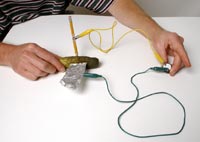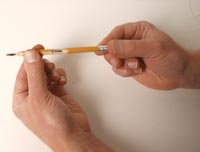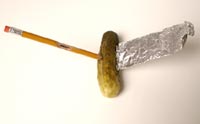|

|

High energy prices got you down? Discover how pickles can ease your troubles.
|
|
|
|
|
|
What Do I Need?
|
.
|
|
•
a pickle
|

|
|
•
a pencil
|
|
•
aluminum foil (unused)
|
|
•
a pocket knife
|
|
•
2 alligator-clip leads (available at RadioShack)
|
|
•
a piezo buzzer, 12V DC (at RadioShack, ask for the Archer 273-065B)
|

|
|
|
|
What Do I Do
?
|
|
|
1.
Fold a sheet of foil several times to make a thick aluminum strip (about 1 inch by 3 inches).
|
|
|
|
|
|
2.
Use a pocket knife to expose about 3/4 inch of graphite at the tip of the pencil, and about 1/2 inch of graphite at the middle. (For the middle part, you only need to expose graphite halfway around the pencil.)

|
|
|
|
|
|
3.
Use the knife to cut a 1-inch lengthwise slit in the pickle, and stick the aluminum strip in the slit. Stick the exposed pencil tip in the pickle, about 3/4 inch from the slit.

|
|
|
|
|
|
4.
Now use an alligator-clip lead to connect the buzzer’s negative terminal to the aluminum strip. Use the other lead to connect the buzzer’s positive terminal to the middle part of the pencil, making sure the clip touches the exposed graphite. Can you hear the buzzer?

|
|
|
|
|
|
5.
If the buzzer stops after awhile, try using a fresh aluminum surface and a new pickle.
|
|
|
|
|
|
What's Going On?
|
.
|
|
You’ve turned your pickle into a battery! Here’s how it works:
Pickles contain salt water, which is rich in charged particles called
ions
. The aluminum and the graphite react with these ions, setting off an electrical tug-of-war between the two materials. The material with the stronger pull—aluminum—takes electrons away from the graphite, triggering a flow of electrons around the circuit. This current powers the buzzer.
Most common batteries—such as your car battery and the batteries inside your flashlight—work on the same principle that your pickle battery works on: They use two metals suspended in an ion-rich liquid or paste to separate electric charge, and create an electrical current around a circuit.
 Share & Discuss:
Discuss your results.
Share & Discuss:
Discuss your results.
|
|
|
- - -
Pickles Home Page
- - -
Kitchen Lab
- - -
|
